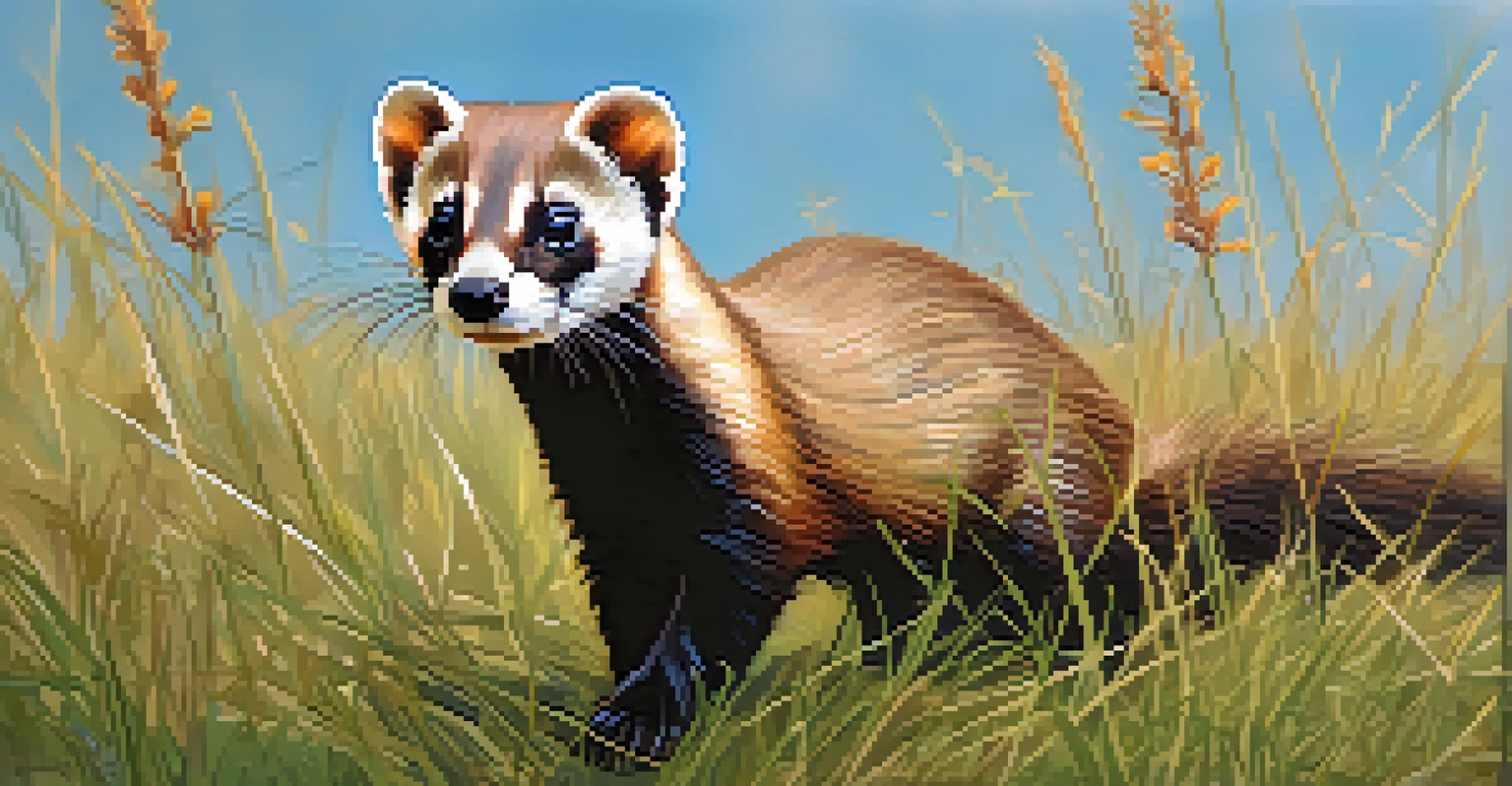Success Stories of Species Recovery in Colorado

The Comeback of the Colorado River Recovery Program
The Colorado River Recovery Program is a shining example of species recovery efforts. This initiative focuses on protecting and restoring native fish species like the endangered Colorado pikeminnow and humpback chub. By improving river habitats and managing water flows, the program has seen these fish populations rebound significantly over the years.
The environment is where we all meet; where we all have a mutual interest; it is the one thing all of us share.
Local communities have played a vital role in this success, participating in habitat restoration projects and educational outreach. This collaborative approach has not only benefited the fish but also enhanced the overall health of the Colorado River ecosystem. It shows that when people come together for a common goal, remarkable transformations can happen.
The impact of the recovery program extends beyond just the fish. Riparian habitats are thriving, supporting various wildlife species and providing recreational opportunities for locals. This success story highlights the importance of investing in our natural resources for the benefit of both wildlife and the community.
Bald Eagles: A Symbol of Hope in Colorado
Once on the brink of extinction, bald eagles have made a stunning recovery in Colorado. Thanks to conservation efforts, including habitat protection and banning harmful pesticides, these majestic birds have returned to their former glory. Today, they're a common sight soaring over lakes and rivers across the state.

The comeback of bald eagles is not just good news for the species, but also for the ecosystem. Their presence indicates a healthy environment, as they play a crucial role in maintaining the balance of their habitats. The sight of these eagles has inspired many to take action in protecting wildlife and preserving natural spaces.
Collaborative Conservation Efforts
The success of species recovery in Colorado highlights the importance of community involvement and collaboration in conservation initiatives.
Moreover, the success of bald eagle recovery fosters a sense of pride among Coloradans. Local birdwatching communities thrive, and educational programs about these iconic birds are flourishing. This connection between people and wildlife reinforces the importance of conservation and the positive effects it can have on local communities.
The Revival of the Black-footed Ferret
The black-footed ferret is a remarkable success story in Colorado, showcasing the power of dedicated conservation efforts. Once declared extinct in the wild, intensive breeding programs and habitat restoration have allowed these small carnivores to be reintroduced into their natural habitat. Their return to the grasslands marks a significant achievement for wildlife recovery.
In every walk with nature one receives far more than he seeks.
Efforts to revive the black-footed ferret involved collaboration among various agencies, including the U.S. Fish and Wildlife Service and local conservation groups. By working together, they created suitable habitats and ensured food sources, leading to a growing ferret population. This teamwork has proven that combined efforts can yield effective results in conservation.
The story of the black-footed ferret serves as a reminder of the resilience of nature and the impact of human intervention. Each sighting of a ferret in the wild ignites hope and encourages ongoing conservation work. It also highlights the importance of protecting ecosystems that support diverse wildlife, ultimately benefiting all of us.
The Successful Reintroduction of Wolves
The reintroduction of wolves into Colorado has sparked significant interest and debate. These apex predators play a vital role in maintaining ecological balance, particularly in controlling deer populations. The successful reintroduction not only helps restore this balance but also brings back the natural dynamics of the ecosystem.
Wolves were once prevalent in Colorado but were eradicated due to habitat loss and hunting. Recent efforts to reintroduce them have involved extensive research and public engagement to address concerns and ensure the safety of both livestock and wildlife. This thoughtful approach has paved the way for a more harmonious coexistence.
Successful Species Comebacks
Various species, including bald eagles and black-footed ferrets, have made remarkable recoveries in Colorado due to dedicated conservation efforts.
The presence of wolves in Colorado has encouraged wildlife tourism and education, fostering appreciation for these magnificent animals. As people learn about their role in the ecosystem, they are more likely to support conservation initiatives. The story of wolf reintroduction illustrates how understanding and respecting nature can lead to positive outcomes for both wildlife and communities.
The Recovery Journey of the Plains Bison
The plains bison, an iconic symbol of the American West, faced near extinction in the late 19th century. Conservation efforts in Colorado have played a pivotal role in bringing these magnificent animals back from the brink. Today, bison herds roam freely in protected areas, showcasing a successful recovery story.
Efforts to recover the plains bison involved creating protected habitats and implementing breeding programs. These initiatives have not only increased bison populations but have also restored the natural grasslands they inhabit. The resurgence of bison highlights the importance of preserving ecosystems that support diverse wildlife.
Moreover, the recovery of plains bison has cultural significance for many Indigenous communities, who view them as a vital part of their heritage. This connection fosters a deeper understanding of conservation's role in maintaining biodiversity and cultural identity. The plains bison's journey reminds us that nature, when given a chance, can heal and thrive.
Conservation of the Northern Leopard Frog
The northern leopard frog is another species that has benefitted from dedicated conservation efforts in Colorado. Once declining due to habitat loss and disease, initiatives aimed at protecting their wetland habitats have led to a resurgence in their populations. These vibrant frogs are now being spotted more frequently throughout the state.
Efforts to conserve the northern leopard frog have included habitat restoration, monitoring programs, and public education. Engaging communities in these initiatives has created a sense of stewardship for local ecosystems. This grassroots approach has proven effective in fostering a culture of conservation and awareness.
Citizen Science Empowers Communities
Citizen science initiatives engage local communities in wildlife monitoring, fostering a deeper connection to nature and promoting conservation responsibility.
The success of the northern leopard frog also serves as a reminder of the interconnectedness of ecosystems. Healthy wetlands not only support frogs but also various other species, from fish to birds. By protecting one species, we can create a ripple effect that benefits the entire ecosystem, highlighting the importance of holistic conservation strategies.
The Impact of Citizen Science on Species Recovery
Citizen science has become a powerful tool in species recovery efforts across Colorado. By involving the public in monitoring wildlife populations and habitats, conservationists can gather valuable data and promote community engagement. This collaborative approach empowers individuals to contribute to the health of their local ecosystems.
Projects like butterfly counts and birdwatching events have seen enthusiastic participation from local communities. These activities not only provide essential information for conservation efforts but also foster a deeper connection between people and nature. As volunteers learn about local species, they become advocates for their protection.

The impact of citizen science extends beyond data collection; it cultivates a sense of ownership and responsibility toward the environment. When people see the direct effects of their contributions, they are more likely to support ongoing conservation initiatives. This collective effort demonstrates how communities can unite for a common cause, ultimately leading to successful species recovery.